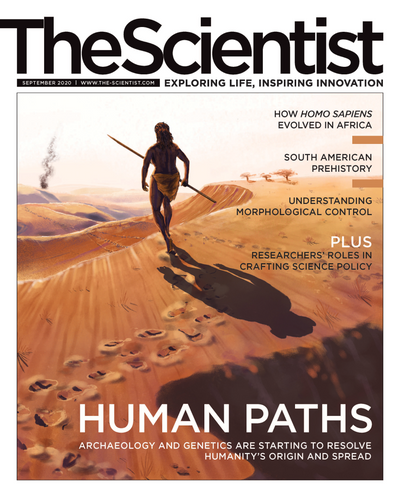ABOVE: © MODIFIED FROM ISTOCK.COM, GIORGIOMORARA
Hominin fossils that reveal clues to the emergence of Homo sapiens are rare in Africa, but in combination with studies of modern human genomes, researchers are piecing together an ever more complex timeline of human history.

 | Genomic analyses suggest that the majority of people living outside Africa today trace most of their ancestry back to a single migration event of a small group of modern humans who left Africa between 60,000 and 70,000 years ago. |
 | Some analyses of modern human genomes hint that Homo sapiens may have interbred with other hominins in Africa. |
 | Comparing ancient DNA from Neanderthals and Denisovans with modern human genomes has revealed that modern humans interbred with these other hominin groups. |
| SAHELANTHROPUS, ORRORIN, ARDIPITHECUS SPP. Members of these relatively small-brained genera probably emerged not long after the human-chimpanzee divergence, and are the first... | |
Excavating a continent
A number of researchers suspect that Homo sapiens arose not in a single place in Africa, but across the entire continent, emerging from a network of interconnected hominin populations. But for decades, archaeologists positioned East and South Africa as important places for hominin evolution and the putative birthplace of our species. That’s likely because most fossils, including groundbreaking findings that have transformed our understanding of human evolution, have been found in those regions.

KABWE, ZAMBIA, 1921 “Kabwe skull,” 300,000 years ago Also called “Broken Hill skull,” the specimen is considered a representative of Homo heidelbergensis. |
| NEAR SAFI, MOROCCO, 1961 Human remains at Jebel Irhoud, 315,000 years ago Flint blades and Homo sapiens–like skeletons in a Moroccan cave known as Jebel Irhoud may represent the oldest Homo sapiens artifacts. The skeletons have modern features such as round skulls and modern-human–like teeth and faces. |
| OMO NATIONAL PARK, ETHIOPIA, 1967-1974 Omo Kibish remains, 195,000 years ago Fragments from two skulls, four jaws, a legbone, a few hundred teeth, and some other bones were found at a site in Ethiopia, and are classified as anatomically modern Homo sapiens. |
| AFAR REGION, ETHIOPIA, 1974 “Lucy,” 3.2 million years ago Lucy—the skeletal remains of an Australopithecus afarensis female—is one of the best-known hominin fossils. Studies suggest that she was both tree-dwelling and capable of an upright gait, providing an important evolutionary stepping stone from more primitive ape species to modern humans. |
| LAKE TURKANA, KENYA, 1984 “Turkana Boy,” 2 million years ago A nearly complete skeleton of an ancient Homo erectus child found near Kenya’s Lake Turkana provides a rare glimpse into how quickly this species reached adulthood and how similar their skeletons were to ours. |
| RISING STAR CAVE, SOUTH AFRICA, 2013 Homo naledi, 236,000–335,000 years ago In 2013 and 2014, cavers found skeletons of two adults and one juvenile of what is believed to be a new species: Homo naledi. Its tiny brain and ape-like shoulders—indicating it was a good climber—suggest it may be an evolutionary off-shoot lineage that went extinct. |
| AFAR REGION, ETHIOPIA, 2013 Adult jawbone, 2.8 million years ago A mandible fragment is the earliest known trace of the genus Homo, although the species it belongs to is a mystery. |
Read the full story.
Interested in reading more?





